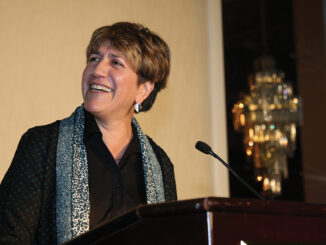
by Rob Callahan

Conflicts in Kentucky coal mines in the early 1930’s produced a pro-labor folksong that famously asks, “Which Side Are You On?” We work in a different time, place, and industry––but the question remains relevant. Conflicts of interest still arise between the bosses who sign our paychecks and the colleagues alongside of whom we work. In such conflicts, we must make a choice: Either stand together with our co-workers, or side with the employers out to undermine them.
This past November, a handful of editors and assistant editors answered that question the wrong way. Thankfully, the story ends happily, despite this betrayal. The tough but ultimately successful struggle for a contract at TV’s The Biggest Loser provides an object lesson in why solidarity matters, how it can go awry, and what it can achieve.
Shortly before their call time on the afternoon of Monday, November 8, 2010, the production crew of The Biggest Loser gathered in the parking lot at the King Gillette Ranch in Calabasas, California, where the show is shot. About 50 individuals huddled in the parking lot on that cool November dusk, talking amongst themselves until they arrived at a clear consensus. They decided that they deserved health and retirement benefits in return for their work, and they resolved that they would take a stand together in order to win those benefits in a union contract. They sent word to the company that production on the reality series could resume only after their employer signed an IATSE agreement.
Usually, when the crew of a non-union production decides to organize, a strike results in a speedy settlement. Most IA job actions end with signed agreements within a few hours. But winning a contract at The Biggest Loser proved a much tougher fight.
After a few hours of the crew’s waiting in the parking lot, the show’s producers approached them to announce that they would not sign a deal that night, and that they expected everyone to report for work as scheduled. The producers made vague but ominous statements about what would happen in the event that people did not come show up on set. The crew then huddled to confer with one another again, and emerged reaffirming its commitment: None of them would return to work until they all went back to work together with a union contract.
Whether because of fear, callousness or a misplaced sense of loyalty, it turns out that most people working in post were on the wrong side.
As the Editors Guild’s LA-based organizer, I had the job of contacting the post-production crew and notifying them of the action their colleagues on the production crew had taken. As a rule, IA contracts cover virtually everybody working in below-the-line crafts on a show—both in production and in post—so folks working in post had a direct stake in this fight for health and retirement benefits. The editors and assistant editors worked in a facility about 40 miles away from the set, and none of them had much contact with employees on the production crew. That distance meant the show’s editors and assistants had neither attended the meeting at which the crew elected to strike, nor been privy to the many quiet conversations that had taken place amongst them in the days leading to the walk-off. But the fact that co-workers may work at a distance, and may be strangers, in no way changes the fundamental need for solidarity.
Fear and Indifference
On the evening of November 8, and in the following days, I reached out to people we knew about working in post-production on the show and made an effort to set up meetings to explain to them the production crew’s action and to answer their questions about the strike. We knew it would be difficult to get assistants and editors to spontaneously step away from their edit bays, but we wanted to ask them to honor any picket line placed outside of their workplace. Unfortunately, many of the editors and assistant editors––almost none of whom were Guild members––proved either too scared or too indifferent to even discuss the matter with a union representative.
Meanwhile, in the two days following the production crew’s walk-out, it became clear that the producers had no interest in negotiating. They refused to discuss the terms of a deal with the IA and instead sought to replace the striking crew members with scabs. Given this serious escalation, we deemed it necessary to raise picket lines at both the production site in Calabasas and the post-production facility in Redondo Beach. A call went out to the membership for volunteers, and Local 700 members began picketing the Redondo Beach facility on Thursday, November 11.
A picket line is the simplest, bluntest means a union has of posing the question, “Which side are you on?” Sadly, the majority of the post-production staff of The Biggest Loser proved unwilling to honor our picket line. Whether because of fear, callousness or a misplaced sense of loyalty, it turns out that most people working in post were on the wrong side. The production crew had brought production on the show to a halt, but post-production proceeded largely without interruption. The fact that employees in post failed to support their colleagues effectively encouraged the company to fight the strikers more aggressively.
True union members come to the defense of their sisters and brothers, even when they have no direct stake in the fight.
The following Monday, November 15, under the cover of pre-dawn darkness, the producers started bringing scabs to the set. For the next few days, they attempted to shoot the show with replacement workers. These were agonizing days for the striking crew, who rightfully worried that they could be permanently robbed of their jobs.
Thankfully, the producers were unable to find many people shameless enough to take a job under such circumstances. Most of those who did were woefully unskilled. The production limped along clumsily with its skeleton crew of strikebreakers and, by the end of the week, the producers realized that they needed to negotiate. Face-to-face talks started that Friday, and a deal was reached by the morning of Monday, November 22. The striking crew voted overwhelmingly and enthusiastically to ratify the agreement, and folks returned to work having won the benefits for which they had fought.
The contract settling the strike will cover employees working in post, as IA agreements almost always do. The company had argued that post-production should be excluded, on the basis that most editors and assistant editors did not participate in the work stoppage. But the IA made clear that, as a matter of principle, we would accept no deal unless it covered everybody.
Lessons Learned
This struggle offers up a number of lessons. Obviously, the fight illustrated our connection and indebtedness to our sisters and brothers working in production crafts. The editors and assistants editors of The Biggest Loser will now enjoy health and retirement benefits, ––not because of anything they did, but because they rode the coattails of courageous colleagues on the production crew. Had editors and assistant editors stood in solidarity with the production crew, the action would likely have looked more like the usual two-hour coup and less like the two-week ordeal it became.
Another lesson, though, is that true union members come to the defense of their sisters and brothers, even when they have no direct stake in the fight. Although most of the post-production staff of The Biggest Loser proved unhelpful during this action, the greater post production community provided strong support. Scores of Local 700 members turned out to picket––many repeatedly––to show that we would not allow the producers to shoot with scabs. Most of these members had never worked on the series and never intended to, but they realized that the striking crew was taking a stand on behalf of everyone who cares about dignity for people working in our industry. The sisters and brothers who answered this call deserve our commendation.
In such conflicts, we must make a choice: Either stand together with our co-workers, or side with the employers out to undermine them.
Lastly and most instructively, the courage and commitment shown by the striking crew demonstrates just what strong solidarity can accomplish. Success in this fight was never assured, and there were doubtless times when crew members must have thought that the safest thing to do, in order to protect their individual livelihoods and their families, would be to return to work. But, once the production crew decided to walk out, none of the strikers returned until the strike was over. They all committed themselves to the fundamental fairness for which they fought, and, more importantly, to one another. Their example inspires us to always remember which side we are on.






